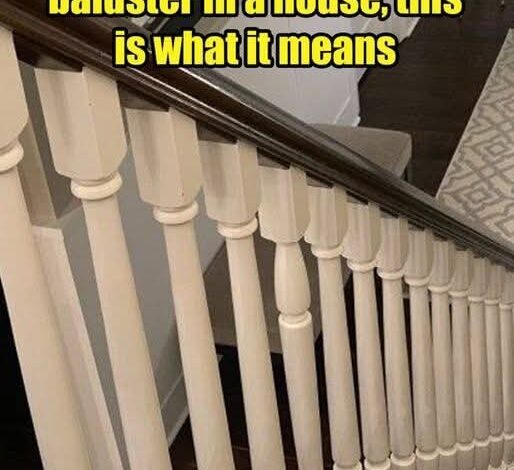
The upside-down baluster on a staircase has hidden purpose
Believers in folklore might find comfort in knowing that an upside-down baluster on a stairway banister is meant to keep evil spirits from inhabiting the upper level of a home.
For those who aren’t superstitious, the asymmetry caused by the inverted vertical pole might just be an annoying quirk, albeit one with significant historical roots.
In the realm of architecture and construction, where craftsmanship and precision meet creativity, age-old traditions and superstitions often blend into the process, adding a touch of mystery to practicality.
One such fascinating practice is the carpenter’s tradition of intentionally installing one baluster – the vertical posts supporting the handrail – upside down in a staircase.
Though it disrupts the uniformity of the staircase’s design, this quirky choice is steeped in historical significance
Spiritual Meaning
According to the Long Island Press, this superstition dates back centuries, to a time when architecture and spirituality were deeply intertwined. Staircases, acting as links between different levels of a building, were often seen as symbolic bridges between the physical world and the spiritual or ethereal realms. Within this belief system, staircases were thought to serve as potential pathways for spirits – both good and bad – traveling between worlds.
To guard against malevolent spirits, carpenters adopted the practice of installing a single upside-down spindle within an otherwise uniform staircase balustrade. This subtle inversion stems from the belief that evil entities could only move in straight, uninterrupted lines. Disrupting the pattern with an inverted spindle was believed to prevent them from heading upstairs and reaching the living spaces above.
The symbolic imperfection is also thought to have been adopted by religious craftsmen to acknowledge that only a divine being is perfect. This practice served as a humble reminder of human fallibility.
Duality and Balance
Beyond its supernatural significance, the upside-down spindle also symbolizes themes of duality and balance. A staircase inherently represents a journey between two states – up and down, one level to another. Incorporating an element of asymmetry, like the inverted spindle, introduces a deliberate balance to this design. This subtle imperfection mirrors the equilibrium sought in both the physical structure and the spiritual protection it was meant to provide.
Common in Old Houses
The inverted baluster is more common than you might think. In 2020, HGTV and DIY Network host Scott McGillivray sparked intrigue on Facebook when he shared a photo of a staircase railing featuring a single upside-down baluster placed near the center of the banister.
“One of these things is not like the other,” he captioned the post, prompting thousands of reactions from curious followers.
Some suggested it was to embrace the imperfections of humanity: “It is common in old houses. The carpenter recognized that only God was perfect, so he put one spindle in upside down to make his work imperfect,” shared one user. Another wrote, “This was done many years ago by religious people who believed if you made something perfect in every way, you were competing with God. It was a sign that you were subservient to God.”
Among the comments, some thought it was a mistake: “Oh man! Maybe they ran out and are hoping the different one won’t be noticeable,” wrote one, while another added, “Mistakes happen!”
Others said it triggered their OCD: “This would probably keep me up at night,” wrote one, and another said, “No one with OCD living in that house! That would drive me crazy!”
These architectural quirks offer more than just aesthetic interest; they provide a window into the values, beliefs, and daily lives of those who lived centuries ago. For modern homeowners and architecture enthusiasts, they serve as reminders of the rich tapestry of human history embedded in the structures we inhabit.
So, the next time you ascend a staircase, take a moment to look closely at the balusters. You might just be standing on a piece of history, where every detail tells a story!




